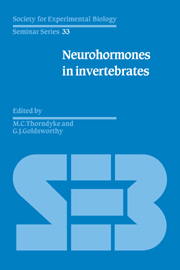Book contents
- Frontmatter
- Contents
- List of contributors
- Preface
- What is special about peptides as neuronal messengers?
- Part I Immunocytochemistry and Ultrastructure
- Part II Arthropod Neurohormones
- Characterization of insect neuropeptides
- The isolation and characterisation of vertebrate-type peptides in insects
- Humoral functions of insect neuropeptides
- Functions of aminergic and peptidergic skeletal motoneurones in insects
- Physiology and biochemistry of crustacean neurohormonal peptides
- Part III Neurohormones in Coelenterates, Annelids and Protochordates
- Part IV Neurohormones in Molluscs
- Index
The isolation and characterisation of vertebrate-type peptides in insects
Published online by Cambridge University Press: 04 August 2010
- Frontmatter
- Contents
- List of contributors
- Preface
- What is special about peptides as neuronal messengers?
- Part I Immunocytochemistry and Ultrastructure
- Part II Arthropod Neurohormones
- Characterization of insect neuropeptides
- The isolation and characterisation of vertebrate-type peptides in insects
- Humoral functions of insect neuropeptides
- Functions of aminergic and peptidergic skeletal motoneurones in insects
- Physiology and biochemistry of crustacean neurohormonal peptides
- Part III Neurohormones in Coelenterates, Annelids and Protochordates
- Part IV Neurohormones in Molluscs
- Index
Summary
Introduction
Vertebrates produce a variety of molecules that are important in controlling and regulating the life processes. Initially, a clear distinction was made between the peptide hormones produced by the endocrine system, and the other major class of regulatory substances, the neurotransmitters, produced by the nervous system. Emphasis was placed on the contrasts between these two types of molecules, and comparisons were made of the differences in the sites of production, methods of release, transportation within the body and the duration of action. On the basis of these comparisons the endocrine and nervous systems were considered to be completely different.
Gradually, however, these two systems have come to be seen as the extremes in a wide spectrum of control mechanisms over biological processes. In between, we have a subtle arrangement and interplay of molecules which cannot, usefully, be categorised as either hormonal or nervous.
A major factor in the shift away from this traditional and separatist view of biological control systems is the finding that the brain produces a great variety of peptides. Indeed, the term ‘endocrine brain’ has been coined (Motta 1980). The discovery of the peptide hormones of the hypothalamus, firstly oxytocin and vasopressin and shortly afterwards the releasing hormones, provided the first clear evidence that certain neurones were peptidergic. Subsequently the phenomenon of neurosecretion has been studied in a wide range of vertebrates and invertebrates.
- Type
- Chapter
- Information
- Neurohormones in Invertebrates , pp. 115 - 140Publisher: Cambridge University PressPrint publication year: 1988
- 3
- Cited by



